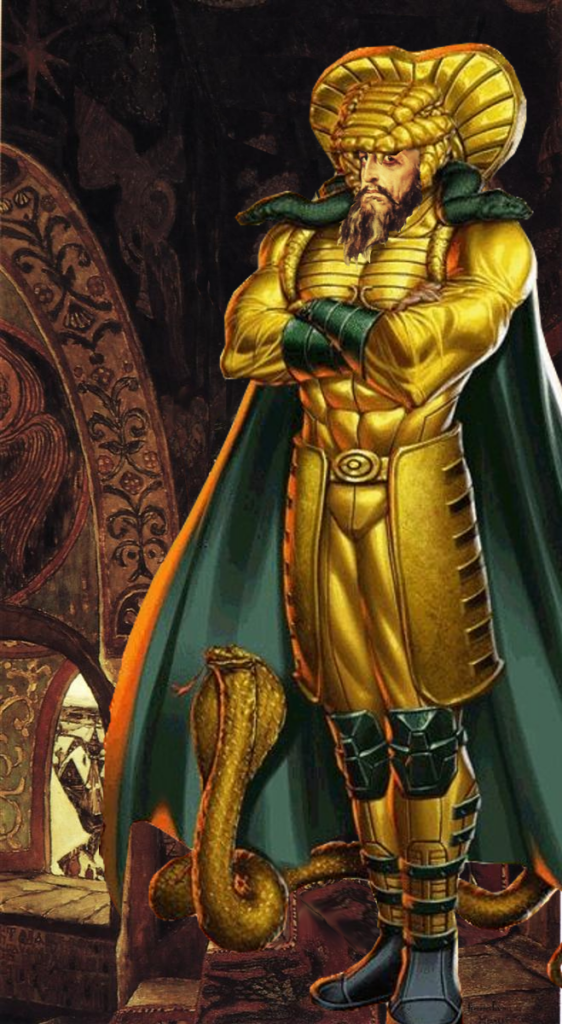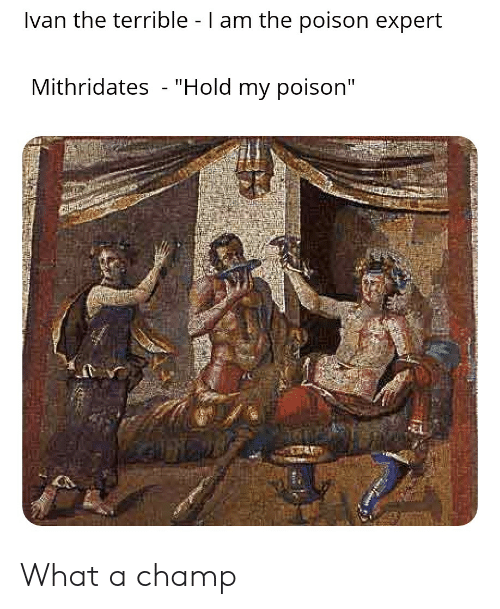Russian Orthodox nationalist ideologists close to the Izborsky Club such as Andrei Fursov, Metropolitan Tikhon (Shevkunov), and Vladimir Medinsky (among several others) have been responsible for creating a neo-Stalinist perspective on Ivan the Terrible which recognizes him as the victim of Western information warfare.
Although I think they are wrong, I will gladly indulge their perceptions of this Western tradition by presenting the argument here that Tsar Ivan likely intentionally poisoned his first three wives in order to achieve contemporary political objectives.

A common feature of the nationalist stories rehabilitating Ivan in an ideological sense are a rejection of Nikolai Karamzin’s popular Russian history (written in the late 18th and early 19th centuries) on the premise that Karamzin’s view was tainted by Western influences, or that he sought to ingratiate himself to his contemporary Romanov patrons.
The ideologists’ information warfare argument appears to derive from a belief that superior Western printing capabilities of the 16th century were able to outpace Russian information (which was largely reliant on an oral tradition). Many of these figures seem to dispute that folkloric interpretations of Ivan were inaccurate. (See Maureen Perrie’s great 1987 book “The Image of Ivan the Terrible in Russian Folklore” for a more nuanced picture as well as a more in-depth relation of the intentional parallels of Ivan to Dracula stories.)
The information produced by these adversaries of Russia is hypothesized by the ideologists to have contributed to an enduring and inaccurate negative image of Tsar Ivan, which Karamzin relied on in his history.
Given that Russia did not acquire a printing press until 1553, nearly 100 years after Gutenberg printed his first bible in Germany in 1455; I believe there may be some logic to this perspective on information warfare. However, it should not be a reason to dismiss all contemporary accounts of his rule which do not agree with the ideological perspective. That is historical revisionism, and an apparent kind of information warfare in it’s own right.
Over the past few months, I’ve been investigating Ivan in the context of both the aforementioned information warfare as well as “offender profiling” of homicidal poisoners. I believe that the figure of Ivan IV has been critically overlooked in the modern day on both of these dimensions. I’ve written a couple of full length papers I hope to publish on the inter-related subject of this apparent ‘Muscovite Mithridates’.

Like the ideologists, my views started with a criticism of Karamzin; who said “the character of loann [Ivan], a hero of virtue in his youth and the pitiless drinker of blood in his adult years and old age, is a riddle for the mind.” Karamzin seems to have seen a change in behavior in Ivan which was triggered by the death of his first wife, Anastasia Romanovna in 1560, thereafter seeing him as a tyrant. This is a view which seems to have been followed by many later historians. (A similar view was expressed by Jerome Horsey as early as the early 17th century who said of Anastasia’s influence on Ivan that: “He being yonge and rioutus, she ruled him with admirable affabellitie and wisdom”.)
With the exception of amongst Old Believers as well as in the the Stalinist period, where Stalin intentionally cultivated a positive image of Ivan IV in propaganda, which he likened his own regime to — Ivan has had a negative image in Russia in general. That may be changing however in the present day.
Whereas Russian nationalists may take exception to the idea that Ivan was never a “hero of virtue”, it was my observation that many historians have come to the conclusion that Ivan IV was a bloodthirsty and ruthless person long before his first marriage.
As a child, he is believed to have thrown small animals to their death from high places for enjoyment; and also to have fatally set dogs on a Boyar in his early teenage years. It is also recorded that he unleashed brutal repressions before his first marriage.
After his first wife, he had six more. The record of their lives doesn’t sound too happy. After the death of Anastasia by a then-rumored poisoning, the second and third wives also died in allegations of poisoning. Wives four, five, and six were forcibly tonsured into monasteries which was a form of “political death” in that culture. Ivan’s seventh wife outlived him and bore a son, Dmitry. (There is a false rumor of an eighth wife executed by drowning, but there is scholarly consensus that it is apocryphal or a forgery.)
In the Muscovy of the 16th century, there was a strong prohibition on divorce and polygamy was forbidden. Further, it was not legal to have more than three marriages. As Byzantine monk Gregory the Theologian (329-390 AD) said of marriage that: “the first is legal, the second is condoned, the third is illegitimate, and that which is beyond is swine- like“.
Contemporary Muscovite politics seem to have been built on a similar system of marriage and kinship traditions, with the central feature being the monarch’s (Grand Prince or Tsar’s) marriage.
In examining the historical record from a modern lens, several facts appear. First, Anastasia Romanovna was definitively poisoned by mercury and possibly also arsenic. (It does not seem that Ivan IV was himself fatally poisoned as has been rumored by Russian nationalist narratives.)
Ivan’s second wife, Maria Temryukovna was alleged to have been poisoned by Ivan himself by the Piscarevsky Chronicler. Not disputing a poisoning death, an official chronicle favorable to Ivan also said Maria had been “poisoned by the hostile malice”. Ivan accused his closest rival, his cousin Vladimir of Staritsa of the poisoning – and had him and his family killed (by poisoning).
Ivan’s third wife died 2 weeks into the marriage. Poison is strongly suspected but modern forensics have not been able to prove it.
In all three of these cases, Ivan accused improbable culprits of the poisonings and used them as justifications to unleash terrors and reforms.
For example in the case of the third wife’s (Marfa Sobakina) poisoning, Ivan blamed not only the once-favored brother of his second wife (Mikhail Temryukovich) but the girl’s own mother of delivering her poison. The mother was executed, and her father was forcibly tonsured. The church begrudgingly appears to have granted the fourth marriage on the basis the third had not been consummated and prior wives had been poisoned.
Even in the case of the short third marriage, it had the effect of marrying the Oprichnik leader Malyuta Skuratov into the family of the tsar – greatly elevating his family’s position (if not that of the oprichniki as an institution) – which seems to have been a critical factor in Boris Godunov’s later accession to the throne. (Ivan of course is rumored and widely believed to have killed his own son by Anastasia, eliminating his lineal successor, and some historians have speculated that this was a direct attack on the kinship politics system of Muscovy – or even a reaction to a fear of succession from his own son in a ‘paranoid’ sense.)
The evidence appears objective however that Ivan utilized conspiracy theories and the marriage politics system to reorganize the government, apparently dodging prohibitions on polygamy with each of the first three deaths.
Beyond this, there is evidence that Ivan sought diplomatic marriages to European nobility in the context of the Livonian War (1558-1583) in 1559-1560, and 1567 when he was still married to his first and second wives. (See records of overture to Catherine Jagiellonka as well as Elizabeth I.)
When combined with modern literature on homicidal poisoning, which highlights personality traits of ruthlessness, sadism, terrorism, relationship escape, and political ambition, and potentially even childhood pathology, Ivan IV actually emerges as a brilliant fit for such killers. We objectively know he did poison some people – such as Vladimir of Staritsa. (Look in these three texts for strong information and facts about the emerging criminological science of profiling homicidal poisoners.)
Further casting doubt on Ivan’s true devotion to Anastasia, a conflicting account appears in official and unofficial histories of Ivan’s grieving process. The official court history reports that he suffered great grief; though an unofficial chronicler notes that Ivan immediately indulged in promiscuous behavior. One week after the death, senior figures beseeched Ivan to remarry quickly. This hasty request is seen by some notable historians as confirmatory of “the tsar’s debauched response to his bereavement” within the culture.
The common features of paranoia and persecutory delusions which Ivan IV is speculated to have possessed by various historians have been also linked to suspicious notions and predilections for poisoning by modern Russian psychiatrists.
Additionally, Ivan’s wives were potentially at high risk for death due to the inherent male sexual proprietariness of the enshrined role of the autocrat. In the culture, women were kept veiled and secluded. While wives of other nobles could remarry after being widowed, the wife of the Grand Prince / Tsar was not allowed to.
In Ivan’s own father’s case, he was only granted a (scandalous) divorce from his first wife of 20 years because she had not borne a male heir. She was forcibly tonsured, and Ivan’s father remarried to Elena Glinskaya (Ivan’s mother – who incidentally died of poisoning when Ivan was just a boy).
Given that Anastasia Romanovna had borne Ivan an heir and was likely still fertile at age 30 when she died; it seems unlikely that the system would have allowed Ivan a similar divorce as his father obtained, or as easily. Given his apparent “shopping” of Catherine Jagiellonka prior to this death, we may view this poisoning with great skepticism in regards to Ivan’s ultimate political ambitions. Ultimately, the poisoning kept the existing power structure intact, but allowed Ivan to add to it. Arguably a divorce would have weakened his power in this circumstance where the tsarevich prince’s mother was still alive.
It was based upon the argument his first wives had been poisoned that he was apparently able to successfully secure a fourth. But we know that he chose to send these next three wives to the monastery; essentially confirming his choice to end the marriages unilaterally. These were not acts of God, but of a man.
A pattern should be apparent to reasonable people at this point, I think.
Why don’t people ask if Ivan murdered his wives? The Russian nationalists like to play a whataboutism regarding Ivan IV and Henry VIII – over the latter’s public executions of his wives. It would seem that Ivan’s approach had been more subtle; but perhaps equally monstrous.
At least all modern observers can agree that Karamzin’s perspective on Ivan is flawed.
